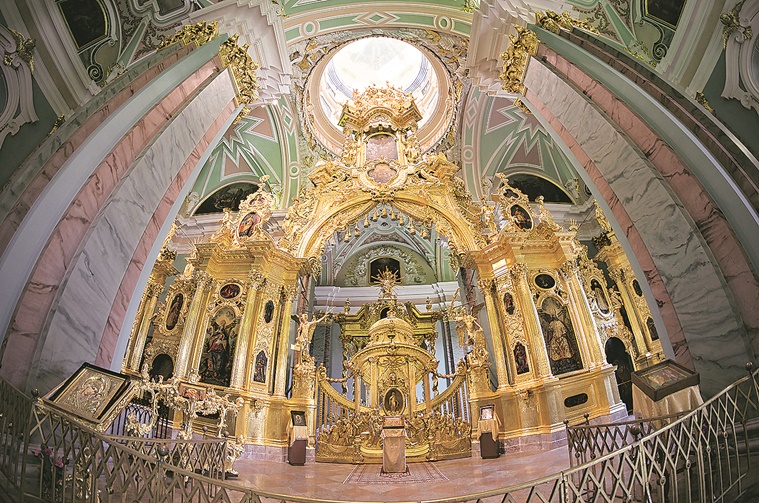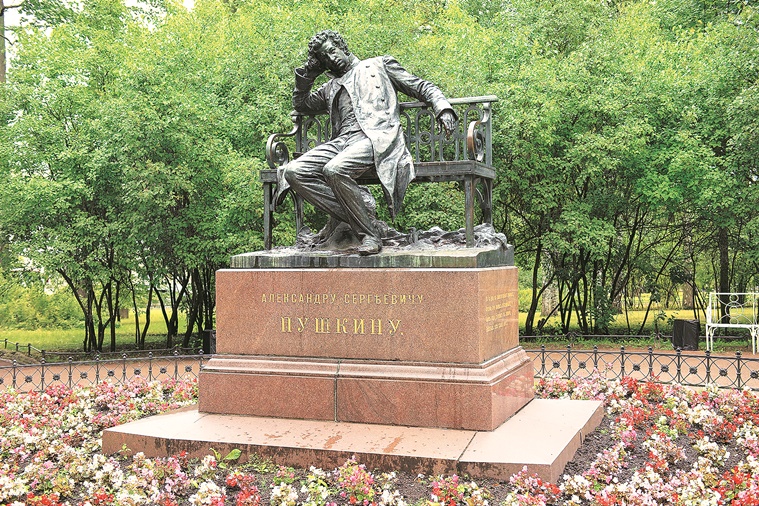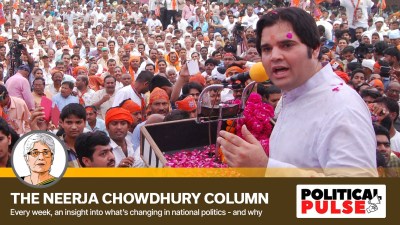- India
- International
Of poets and royal treasures: Spoils of Russian tsars and Pushkin
The spoils of Russian tsars will take a lifetime to go through and appreciate. But, it’s easier to find sustenance in the country’s favourite poet, Alexander Sergeyevich Pushkin.
 An aerial view of St Petersburg. (Source: Bangalore News Photos)
An aerial view of St Petersburg. (Source: Bangalore News Photos)
Remember, no one smiles in Russia. Never smile at the babushkas. Do not smile at all. I had just hopped off the 1,068 ft long, 145,656 tonne Norwegian Getaway cruise liner when Alexsey, our guide, belched instructions. The St Petersburg sky wore a doleful grey and tubby raindrops fell briskly on the bus windowpane. “Wait, did you forget your sunglasses?” Alexsey hooted. Sunglasses on a day so dour? I knitted the brows. “You will need sunglasses to cut the blinding gold-glare at Catherine’s Palace. 100 kg of pure gold, cupolas gilded in gold, chairs, tables and picture frames, golden carvings, chandeliers, angel figurines — everything in gold,” he quipped.
As the bus crawled through 800 bridges and 8,000 landmarks of St Petersburg towards the town of Pushkin, fellow tourists turned geeky mathematicians. Price of 100 kg of gold in 1756. Russian ruble. Dollars. Euros. They swiftly added, multiplied, divided to assess how much Catherine I spent on the 325-metre long palace. Tsars do not count cheddar, do they? I wanted to scuttle all mathematics on the bus, but my mind was beeping pentameters. A love poem. “I keep in mind that magic moment, When you appeared before my eyes, Like ghost, like fleeting apparition, Like genius of the purest grace…” Alexander Sergeyevich Pushkin, Russia’s greatest poet’s most famous poem. It was not a random thought – I was in the town named after Pushkin. And he was there. Sitting lazily on a bench near Catherine’s Palace with yellow oak leaves gathered at his feet in tribute.
 The Palace Square with the Hermitage. (Source: Bangalore News Photos)
The Palace Square with the Hermitage. (Source: Bangalore News Photos)
I walked past his statue to the Palace, so huge that I squinted my eyes to fit its 325-long belly into one frame — its azure and white stucco facade, the onion cupolas of the chapel and its thousands of statues. I squinted again to decipher why Empress Catherine the Great described it as “whipped cream” architecture. Cream, no. It was unending gold in the rooms where once queens in velvet and kings in breeches waltzed, played cards, dined on pirozhki, vatrushka, chebureki, frikadeller and snoozed under bright chandeliers and painted walls.Catherine’s Palace is so ornate that it can even tempt a hermit. But nothing is more alluring than the Amber Room, a wall panelled with precious amber currently valued at roughly 400 million dollars. The amber dazzles the eye, its ostentation a reminder of the extravagance of the Russian tsars which the Germans burnt and vandalised during World War II.
Afterwards, I drove past Tikhvin Cemetery in Alexander Nevsky Monastery, where writer Fyodor Dostoyvesky and composer Pyotr Tchaikovsky are buried. On the streets, I could hear the footsteps of Vladimir Nobokov (the creator of Lolita) who lived in St Petersburg until the age 18, and of Alexander Blok, the poet who wrote the lyrical The Twelve.
 The interior of the Peter and Paul Cathedral. (Source: Bangalore News Photos)
The interior of the Peter and Paul Cathedral. (Source: Bangalore News Photos)
I wanted to walk to Nikolai Gogol’s house, but the master was waiting in The Hermitage, perhaps the world’s largest museum with three million artifacts (the numismatic collection accounts for one-third of them) displayed in nearly 400 rooms spread over three floors of six interlinked historic buildings. The Hermitage houses the former imperial collection of the tsars, which began some 300 years ago when Peter the Great started acquiring pictures and artefacts; the collection was later hugely augmented in the late 18th century by Catherine the Great.

I stood in front of van Gogh’s White House at Night, an oil on canvas painting created on June 16, 1890, barely six weeks before his death. The Hermitage describes it as an expression of the “great psychological tension under which van Gogh found himself…” I looked at the red roof and bright star and tried to gauge Gogh’s anguish. I had to forego Rembrandt’s depiction of forgiveness in his 1669 painting, The Return of the Prodigal Son. I had no time. If I stared at each of the three million artefacts in The Hermitage for only 30 seconds each, it would take eight years. I had to return to the ship to sail to Helsinki. As Pushkin said: “As the years are fleeting, And however many there seem to be, We must all go under the eternal vault…” Not the eternal vault. Not yet. Just the blue of the sea. And Pushkin.

Apr 25: Latest News
- 01
- 02
- 03
- 04
- 05



































